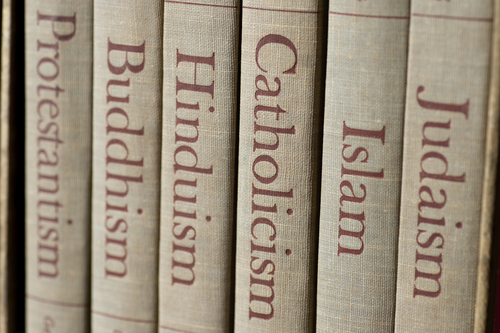
May 12, 2015; Pew Research Center
While the decline in religious affiliation noted in the new Pew Research Center study will challenge churches, mosques, synagogues, and religiously affiliated nonprofits, the study presents a challenge to the entire nonprofit sector and our nation as a whole.
The Pew Study was based on a telephone survey of more than 35,000 and replicates a study conducted in 2007. Among the key findings of the Pew study that show a decline in the importance of religious ties and a change in the nature of America’s religious culture, we see:
- While 70.6% of Americans self-identify as having a religious affiliation, that is significantly lower than the more than 78 percent who identified as having a religious affiliation seven years earlier. The “unaffiliated” now represent the second-largest segment of the American population, and the number of unaffiliated grew rapidly over the past seven years.
{source}
<a href=”http://www.pewforum.org/2015/05/12/americas-changing-religious-landscape/pr_15-05-12_rls-00/”><img width=”420″ height=”714″ src=”http://www.pewforum.org/files/2015/05/PR_15.05.12_RLS-00.png” alt=”Christians Decline as Share of U.S. Population; Other Faiths and the Unaffiliated Are Growing” /></a>
{/source}
Sign up for our free newsletters
Subscribe to NPQ's newsletters to have our top stories delivered directly to your inbox.
By signing up, you agree to our privacy policy and terms of use, and to receive messages from NPQ and our partners.
- Even as their numbers declined, American Christians, like the U.S. population as a whole, became more racially and ethnically diverse. Non-Hispanic whites now account for smaller shares of evangelical Protestants, mainline Protestants, and Catholics than they did seven years earlier, while Hispanics have grown as a share of all three religious groups.
- While many U.S. religious groups are aging, the unaffiliated are comparatively young—and getting younger, on average, over time. As a rising cohort of highly unaffiliated Millennials reaches adulthood, the median age of unaffiliated adults has dropped to 36, down from 38 in 2007 and far lower than the general (adult) population’s median age of 46.4. By contrast, the median age of mainline Protestant adults in the new survey is 52 (up from 50 in 2007) and the median age of Catholic adults is 49 (up from 45 seven years earlier).
{source}
<a href=”http://www.pewforum.org/2015/05/12/americas-changing-religious-landscape/pr_15-05-12_rls-01/”><img width=”640″ height=”427″ src=”http://www.pewforum.org/files/2015/05/PR_15.05.12_RLS-01.png” alt=”Generational Replacement Helping Drive Growth of Unaffiliated, Decline of Mainline Protestantism and Catholicism” /></a>
{/source}
- But even among older cohorts, the number of unaffiliated adults has grown sharply. About a third of older Millennials (adults currently in their late 20s and early 30s) now say they have no religion, up nine percentage points among this cohort since 2007, when the same group was between ages 18 and 26. Nearly a quarter of Generation X’ers now say they have no particular religion or describe themselves as atheists or agnostics, up four points in seven years. Baby Boomers also have become slightly but noticeably more likely to identify as religious “nones” in recent years.
- While still representing a small part of the total American population, the share of the public identifying with religions other than Christianity has grown from 4.7 percent in 2007 to 5.9 percent in 2014. Gains were most pronounced among Muslims (who accounted for 0.4 percent of respondents in the 2007 Religious Landscape Study and 0.9 percent in 2014) and Hindus (0.4 percent in 2007 vs. 0.7 percent in 2014).
- Across the population, interfaith relationships are common among married people and those living with a romantic partner, and interfaith marriage appears to be on the rise.
The central role played by religion in supporting American philanthropy was noted in an earlier study conducted by Independent Sector in cooperation with the National Council of Churches. It found that among “givers to religious congregations, over 85 percent also support secular organizations, providing three-quarters of the philanthropic support those other organizations receive.” Furthermore, “nearly 70 percent of all giving households give to religious congregations, with an average annual contribution to all charities of $2,104. In contrast, 31.4 percent of households give only to secular organizations, with an annual contribution of $623.”
The report of the World Giving Index this year reinforces the link between levels of giving and religion by pointing out the cultural setting for the country with the highest national level of giving:
“Nine out of ten people within Myanmar follow the Theravada school of Buddhism, under which the lives of the Sangha (ordained monks and nuns) are supported by dana (charitable giving) by lay followers of the religion. This clearly translates into a strong culture of charity, with Myanmar ranked first for donating money and 13 percentage points ahead of the second placed country. Sri Lanka, another country with a strong Theravada Buddhist community, also ranked within the Top 10 of the World Giving Index (placed 9th).”
But another report, this one from IUPUI, on women, religion and giving suggests that the relationship between religiosity and giving may be fraying in this country, at least among women. That report stated:
- Younger, single women who are not religiously affiliated, referred to here as “nones,” give on average twice as much as women who are affiliated with religious institutions, but only attend services infrequently.
- Younger single “none” women give twice as much to institutions that are not religiously affiliated as they do to those that are.
- Among younger “nones” of both sexes, women give twice as much as men.
- Younger women who are “nones” give two-and-a-half times as much to charitable organizations as older women who are also “nones.”
Whatever it is that is occurring relative to the link between religion and giving, nonprofits would do well to keep an eye on it.—Martin Levine













